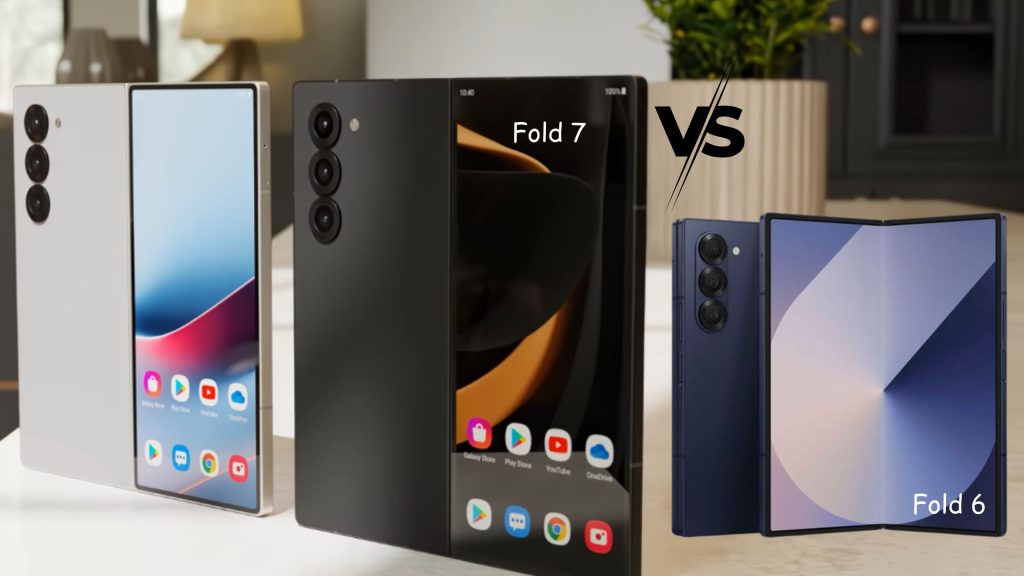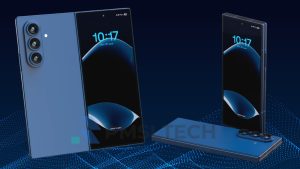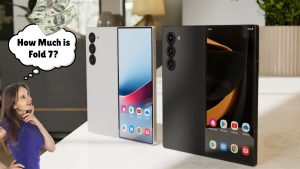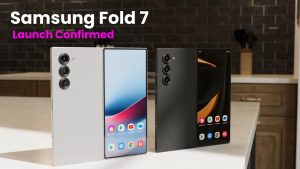Samsung’s Galaxy Z Fold series continues to push the boundaries of foldable smartphone technology, setting the standard for innovation in the premium mobile market. With the Galaxy Z Fold 7 expected to launch in July 2025, anticipation is high for what upgrades Samsung will introduce over its predecessor, the Galaxy Z Fold 6.
Provides an in-depth comparison of the two devices, focusing on design, display, performance, cameras, battery, software, and more. Below, we present the key differences and similarities in a readable table format, followed by a detailed analysis of each category.
Samsung Galaxy Z Fold 7 vs. Galaxy Z Fold
| Feature | Galaxy Z Fold 6 | Galaxy Z Fold 7 |
| Release Date | July 2024 | Expected July 2025 |
| Unfolded Dimensions | 153.5 x 132.6 x 5.6 mm | 158.4 x 143.1 x 4.5 mm |
| Folded Dimensions | 153.5 x 68.1 x 12.1 mm | 158.4 x 73.4 x 9.5 mm |
| Weight | 239 g | 236 g |
| Inner Display | 7.6-inch Dynamic AMOLED 2X, 2160 x 1856, 120Hz, 2600 nits | 8.2-inch Dynamic AMOLED 2X, ~2560 x 2100 (est.), 120Hz, 2600 nits |
| Cover Display | 6.3-inch Dynamic AMOLED 2X, 2376 x 968, 120Hz, 2600 nits | 6.5-inch Dynamic AMOLED 2X, ~2520 x 1080 (est.), 120Hz, 2600 nits |
| Crease Visibility | Noticeable crease | Reduced or nearly invisible crease |
| Processor | Snapdragon 8 Gen 3 for Galaxy | Snapdragon 8 Elite for Galaxy (or Exynos 2500 in some regions) |
| RAM | 12 GB | 12 GB (possible 16 GB variant) |
| Storage Options | 256 GB, 512 GB, 1 TB (UFS 4.0) | 256 GB, 512 GB, 1 TB (UFS 4.0) |
| Main Camera | 50 MP (f/1.8, OIS) | 200 MP (f/1.8, OIS, rumored) |
| Ultrawide Camera | 12 MP (f/2.2, 123° FOV) | 12 MP (f/2.2, 123° FOV) |
| Telephoto Camera | 10 MP (f/2.4, 3x optical zoom) | 10 MP (f/2.4, 3x optical zoom) |
| Cover Selfie Camera | 10 MP (f/2.2) | 10 MP (f/2.2) |
| Under-Display Camera | 4 MP (f/1.8) | 4 MP (f/1.8, improved quality) |
| Battery Capacity | 4400 mAh | 4400 mAh |
| Charging Speed | 25W wired, 15W wireless, 4.5W reverse wireless | 45W wired (rumored), 15W wireless, 4.5W reverse wireless |
| Operating System | Android 14 with One UI 6.1 (upgradable to One UI 7) | Android 16 with One UI 8 |
| IP Rating | IP48 (water and dust resistance) | IP48 or better |
| S Pen Support | Yes (no built-in storage) | Yes (no built-in storage) |
| Price (Base Model) | $1899 | $1899–$1999 (estimated) |
| Colors | Silver Shadow, Pink, Navy, White, Crafted Black | TBD (expected vibrant options) |
Detailed Comparison of Samsung Galaxy Z Fold 7 vs. Galaxy Z Fold
1. Design and Build Quality
The Galaxy Z Fold 6 introduced a refined design with a flatter, more symmetrical look, drawing inspiration from the Galaxy S24 Ultra. It shaved off weight (239 g) and thickness (5.6 mm unfolded, 12.1 mm folded) compared to its predecessors, making it more pocket-friendly. The hinge mechanism was improved for durability and a flush fold, and the IP48 rating provided water and dust resistance—a first for Samsung foldables.
The Galaxy Z Fold 7 is rumored to take this refinement further, potentially becoming Samsung’s thinnest foldable yet. Leaked CAD renders suggest dimensions of 158.4 x 143.1 x 4.5 mm unfolded and 158.4 x 73.4 x 9.5 mm folded, a significant reduction from the Fold 6’s 5.6 mm and 12.1 mm. This makes it competitive with ultra-thin foldables like the Oppo Find N5 (4.2 mm unfolded).
The Fold 7 is also expected to be slightly lighter at 236 g, despite larger displays. A more rounded design, similar to the Galaxy S25 Ultra, and thinner bezels (0.5 mm vs. 1.9 mm on the Fold 6) could enhance aesthetics and usability.
Key Upgrades:
- Thinner profile (4.5 mm unfolded, 9.5 mm folded vs. 5.6 mm and 12.1 mm).
- Slightly lighter weight (236 g vs. 239 g).
- Rounded design with thinner bezels for a modern look.
Verdict: The Fold 7’s design improvements focus on portability and aesthetics, making it feel more like a conventional flagship when folded. While the Fold 6 was a step forward, the Fold 7 could set a new standard for foldable ergonomics.
2. Display
The Galaxy Z Fold 6 features a 7.6-inch Dynamic AMOLED 2X inner display (2160 x 1856, 120Hz, 2600 nits) and a 6.3-inch cover display (2376 x 968, 120Hz, 2600 nits). The cover screen’s 22:9 aspect ratio was wider than the Fold 5’s, improving typing comfort, but it remained narrower than competitors like the Google Pixel 9 Pro Fold. The crease on the inner display was still noticeable, though less distracting than on earlier models.
The Galaxy Z Fold 7 is expected to push display boundaries with an 8.2-inch inner display and a 6.5-inch cover display, both Dynamic AMOLED 2X with 120Hz refresh rates and 2600 nits peak brightness. The larger inner screen (~2560 x 2100 estimated) offers more real estate for multitasking and media, while the wider cover screen (~2520 x 1080) addresses complaints about the Fold 6’s narrow outer display. Samsung is also rumored to have minimized the crease, potentially matching the near-crease-free displays of competitors like the Honor Magic V3.
Key Upgrades:
- Larger displays (8.2-inch inner, 6.5-inch cover vs. 7.6-inch and 6.3-inch).
- Wider cover screen for better usability.
- Reduced or nearly invisible crease.
Verdict: The Fold 7’s larger, wider, and potentially creaseless displays make it a significant upgrade for productivity and media consumption. The Fold 6’s displays are excellent, but the Fold 7 promises a more immersive experience.
3. Performance
The Galaxy Z Fold 6 is powered by the Snapdragon 8 Gen 3 for Galaxy, a 4nm chip optimized for Samsung devices. Paired with 12 GB of RAM and up to 1 TB of UFS 4.0 storage, it delivers flagship performance for gaming, multitasking, and AI tasks. The chip’s Neural Processing Unit (NPU) supports Galaxy AI features like Sketch to Image and Composer. A 1.6x larger vapor chamber improves thermal management compared to the Fold 5.
The Galaxy Z Fold 7 is expected to feature the Snapdragon 8 Elite for Galaxy, built on a 3nm process for better efficiency and performance. Benchmarks suggest a 30% boost in CPU performance and enhanced graphics, ideal for demanding applications.
Some regions may receive an Exynos 2500 variant, though its performance remains unconfirmed. RAM is likely to stay at 12 GB, with rumors of a 16 GB option for AI-intensive tasks. The same storage options (256 GB, 512 GB, 1 TB) are expected.
Key Upgrades:
- Snapdragon 8 Elite (3nm) vs. Snapdragon 8 Gen 3 (4nm).
- Possible 16 GB RAM variant.
- Enhanced AI and graphics performance.
Verdict: The Fold 7’s processor upgrade ensures it remains future-proof for AI and high-performance tasks. The Fold 6 is no slouch, but the Fold 7’s efficiency and power gains are notable.
4. Camera System
Cameras have been a weak point for Samsung’s Fold series compared to its Galaxy S Ultra line. The Galaxy Z Fold 6 retained the same setup as the Fold 5: a 50 MP main camera (f/1.8, OIS), 12 MP ultrawide (f/2.2, 123° FOV), 10 MP telephoto (f/2.4, 3x zoom), 10 MP cover selfie camera, and 4 MP under-display camera. While software enhancements improved processing, the hardware lagged behind competitors like the Galaxy S24 Ultra.
The Galaxy Z Fold 7 is rumored to address this with a 200 MP main sensor, potentially the same as the Galaxy S25 Ultra. This would significantly enhance detail and low-light performance. The ultrawide (12 MP), telephoto (10 MP), and selfie cameras (10 MP cover, 4 MP under-display) are expected to remain unchanged, though the under-display camera may see quality improvements. Samsung’s image processing is also likely to be refined for better color accuracy and dynamic range.
Key Upgrades:
- 200 MP main camera vs. 50 MP.
- Improved under-display camera quality.
- Enhanced image processing.
Verdict: The Fold 7’s camera upgrade could finally bring it closer to Samsung’s non-foldable flagships, making it a compelling choice for photography enthusiasts. The Fold 6’s cameras are functional but outdated.
5. Battery and Charging
The Galaxy Z Fold 6 has a 4400 mAh battery, adequate for a full day of moderate use but trailing behind competitors with larger capacities (e.g., Vivo X Fold 3 Pro’s 5700 mAh). Charging speeds are modest at 25W wired, 15W wireless, and 4.5W reverse wireless, taking about 80 minutes for a full charge. Battery life in tests showed 11 hours and 20 minutes of video streaming on the main screen.
The Galaxy Z Fold 7 is rumored to retain the 4400 mAh battery, a disappointment given its larger displays and thinner design. However, the Snapdragon 8 Elite’s efficiency may improve battery life slightly. A rumored upgrade to 45W wired charging would reduce charging time to around 60 minutes, aligning with modern flagships. Wireless and reverse wireless charging are expected to remain at 15W and 4.5W.
Key Upgrades:
- 45W wired charging vs. 25W.
- Potential battery life improvements via chip efficiency.
Verdict: The Fold 7’s faster charging is a welcome upgrade, but the unchanged battery capacity is a missed opportunity. The Fold 6’s battery life is decent but not exceptional.
6. Software and AI
The Galaxy Z Fold 6 launched with Android 14 and One UI 6.1, featuring Galaxy AI tools like Circle to Search, Sketch to Image, and Composer. It offers seven years of software updates, ensuring support until 2031. One UI 7 (based on Android 15) is expected to roll out in 2025, adding AI Select and improved multitasking.
The Galaxy Z Fold 7 is expected to debut with Android 16 and One UI 8, offering a refreshed interface, enhanced privacy controls, and new AI features. Leaked benchmarks suggest deeper integration of Gemini-based AI, potentially surpassing the Fold 6’s capabilities. The same seven-year update commitment is likely.
Key Upgrades:
- Android 16 with One UI 8 vs. Android 14 with One UI 6.1.
- Advanced AI features and improved multitasking.
Verdict: The Fold 7’s software will be more future-ready, with a smoother and more intelligent user experience. The Fold 6 remains capable but will require updates to match.
7. Price and Value
The Galaxy Z Fold 6 launched at $1899 for the 256 GB model, a $100 increase over the Fold 5. Higher storage variants (512 GB, 1 TB) cost $2019 and $2259, respectively. Its iterative upgrades disappointed some users given the price hike.
The Galaxy Z Fold 7’s price is unconfirmed, but rumors suggest a starting price of $1899–$1999. Given the significant upgrades (thinner design, larger displays, 200 MP camera, faster charging), a slight increase could be justified. Trade-in deals and carrier promotions may offset costs.
Key Considerations:
- Fold 7 may maintain or slightly increase base price.
- More substantial upgrades could justify cost.
Verdict: The Fold 7 offers better value if priced similarly to the Fold 6, given its advancements. The Fold 6 is a safer buy if discounted heavily.
8. Additional Features
Both devices support the S Pen (sold separately) for productivity, but neither includes built-in storage. The Fold 7 may improve stylus responsiveness on its larger, creaseless display. Connectivity (5G, Wi-Fi 6E, Bluetooth 5.3) and IP48 rating are expected to carry over, though the Fold 7 may enhance dust resistance. Color options for the Fold 7 are unconfirmed but likely to include vibrant choices like the Fold 6’s Silver Shadow, Pink, and Navy.
Key Upgrades:
- Potentially improved S Pen experience.
- Possible enhanced IP rating.
Verdict: Minor improvements in accessories and durability give the Fold 7 a slight edge.
Should You Upgrade
For Galaxy Z Fold 6 Owners
The Galaxy Z Fold 7’s upgrades—thinner design, larger displays, reduced crease, 200 MP camera, faster charging, and newer software—are compelling but may not justify an upgrade for Fold 6 owners unless they prioritize photography or a sleeker form factor. Waiting for discounts on the Fold 7 or holding onto the Fold 6 for another year is advisable.
For Galaxy Z Fold 5 or Older Owners
If you’re using a Fold 5 or earlier, the Fold 7 is a significant leap. Its thinner profile, larger screens, improved cameras, and modern processor make it a worthy upgrade, especially for productivity and media enthusiasts. The Fold 6 is a viable alternative if you find a good deal, but the Fold 7’s advancements are more future-proof.
For New Buyers of Samsung Galaxy Z Fold 7 vs. Galaxy Z Fold
New buyers choosing between the Fold 6 and Fold 7 should wait for the Fold 7’s launch in July 2025. Its design refinements, camera improvements, and performance boosts make it a better long-term investment, especially if priced competitively. If you need a foldable now, the Fold 6 is still a top-tier option, particularly at a discount.
The Samsung Galaxy Z Fold 7 is shaping up to be a substantial evolution over the Galaxy Z Fold 6, addressing key pain points like design thickness, display crease, and camera performance. While the Fold 6 was a refined but iterative update, the Fold 7 promises to redefine Samsung’s foldable lineup with a thinner profile, larger screens, a 200 MP camera, and faster charging. The unchanged battery capacity and potentially higher price may give some buyers pause.
For those invested in Samsung’s ecosystem or seeking the ultimate foldable experience, the Galaxy Z Fold 7 is poised to deliver. Whether it’s worth the upgrade or purchase depends on your priorities -photography, portability, and future-proofing favor the Fold 7, while value and immediate availability tilt toward the Fold 6. We await Samsung’s official unveiling, the Fold 7’s rumored specs suggest it could be the foldable to beat in 2025.
FAQs
1. What are the main differences between Samsung Fold 7 vs Fold 6?
Samsung Fold 7 vs Fold 6 comparison shows that Fold 7 features a slimmer design, improved hinge, brighter display, and a faster Snapdragon chip.
2. Is the Samsung Galaxy Fold 7 worth upgrading from Fold 6?
Yes, if you want better performance, enhanced multitasking features, and design refinements, the Samsung Fold 7 vs Fold 6 upgrade is worth it for power users.
3. What is the price difference between Samsung Fold 7 and Fold 6?
Samsung Fold 7 vs Fold 6 price difference is expected to be minimal at launch, with Fold 7 likely starting around ₹1.55 Lakh, similar to Fold 6.
4. Does the Samsung Fold 7 have better camera than Fold 6?
Yes, Samsung Fold 7 brings software-powered camera upgrades and better low-light performance compared to the Fold 6, though hardware changes are minimal.
5. How is the battery life on Samsung Fold 7 vs Fold 6?
Samsung Fold 7 vs Fold 6 battery life is slightly better in Fold 7 due to improved power efficiency with the Snapdragon Gen 4 chip and software optimization.
6. Which has a better display – Samsung Fold 7 or Fold 6?
Fold 7 offers a brighter and more color-accurate display, making it slightly superior in the Samsung Fold 7 vs Fold 6 screen comparison.
7. Are there design changes in Samsung Fold 7 vs Fold 6?
Yes, Samsung Fold 7 is thinner, lighter, and has a refined hinge mechanism compared to Fold 6, enhancing durability and portability.
8. Should I wait for Samsung Fold 7 or buy Fold 6 now?
If you want the latest tech and improvements, wait for Fold 7. If you’re on a budget and find a deal, Fold 6 is still an excellent foldable phone.





